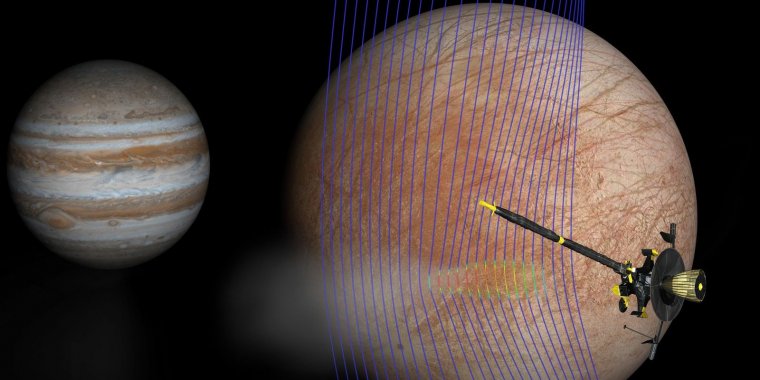| News / Science News |
Old Data Reveal New Evidence of Europa Plumes
Data collected by NASA's Galileo spacecraft in 1997 were put through new and advanced computer models to untangle a mystery -- a brief, localized bend in themagnetic field -- that had gone unexplained until now. Previous ultraviolet images from NASA's Hubble Space Telescope in 2012 suggested the presence of plumes, but this new analysis used data collected much closer to the source and is considered strong, corroborating support for plumes.

Artist's illustration of Jupiter and Europa (in the foreground) with the Galileo spacecraft after its pass through a plume erupting from Europa's surface. Image credit: NASA/JPL-Caltech/Univ. of Michigan.
The research was led by Xianzhe Jia, a space physicist at the University of Michigan in Ann Arbor.
Jia's team was inspired to dive back into the Galileo data by Melissa McGrath of the SETI Institute in Mountain View, California. A member of the Europa Clipper science team, McGrath delivered a presentation to fellow team scientists, highlighting other Hubble observations of Europa.
"One of the locations she mentioned rang a bell. Galileo actually did a flyby of that location, and it was the closest one we ever had. We realized we had to go back," Jia said. "We needed to see whether there was anything in the data that could tell us whether or not there was a plume."
At the time of the 1997 flyby, about 124 miles (200 kilometers) above Europa's surface, the Galileo team didn't suspect the spacecraft might be grazing a plume erupting from the icy moon. Now, Jia and his team believe, its path was fortuitous.
When they examined the information gathered during that flyby 21 years ago, sure enough, high-resolution magnetometer data showed something strange.
Drawing on what scientists learned from exploring plumes on Saturn's moon Enceladus -- that material in plumes becomes ionized and leaves a characteristic blip in the magnetic field -- they knew what to look for. And there it was on Europa -- a brief, localized bend in the magnetic field that had never been explained.
The findings are good news for the Europa Clipper mission, which may launch as early as June 2022. From its orbit of Jupiter, Europa Clipper will sail close by the moon in rapid, low-altitude flybys. If plumes are indeed spewing vapor from Europa's ocean or subsurface lakes, Europa Clipper could sample the frozen liquid and dust particles.
If plumes exist, and we can directly sample what's coming from the interior of Europa, then we can more easily get at whether Europa has the ingredients for life. (NASA)
YOU MAY ALSO LIKE


